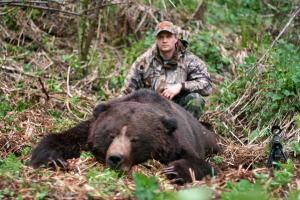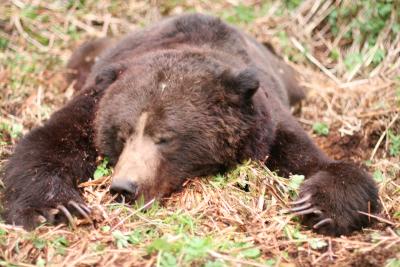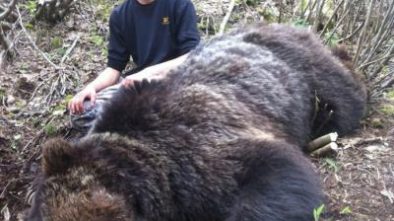Grizzly Bear Hunting Tips

Hunter with grizzly bear
Grizzly bears are slightly smaller than the Alaskan Brown bears but nevertheless one of the most aggressive and strongest among the bear species found in North America.
Grizzlies occupy the top spot of the food chain along with humans in North America. It is a formidable animal to face in the wild. Grizzly’s are known to be omnivorous in their diet and in some cases they attack humans.
The hunting of Grizzly bears is allowed liberally in some areas of North America as the healthy bear population is affecting the moose and caribou numbers negatively. However in some areas the hunter is allowed to hunt only one grizzly every four years. In British Columbia where it has become necessary to limit the number of animals taken, limited entry hunting regulations apply. It creates hunting opportunities to residents of British Columbia via a lottery system to those who legally posses a B.C. resident hunter number. Non-residents can go on guided hunting trips with licensed outfitters, as they are well aware of hunting regulations and the best hunting grounds, this will ensure a safer and more enjoyable hunting trip.
Get your paper work read y before embarking on a bear-hunting trip. Gun permit, A hunting license, and You will need to register your weapons at Canadian Customs.
y before embarking on a bear-hunting trip. Gun permit, A hunting license, and You will need to register your weapons at Canadian Customs.
Grizzly Habitat
Grizzly bears are generally found in the high country above timber lines in the interiors of partially forested areas. They are formidable predators and their diet typically consist of berries, roots, grasses, many kinds of plants, land squirrels, new born caribou, moose and other wild life. They are also known to kill and consume adult moose and caribou.
Grizzly Hunting Season
Both spring and fall are good seasons to hunt grizzlies. In spring the coat of grizzly is denser with thick long hair and sharper claws resulting in high quality hides.
In fall the bears are at they’re heaviest and also the density of the bears in hunting areas around salmon streams increases.
Time your bear hunting during spring as the weather is good, daylight hours are long and it is easier to spot and stalk feeding bears against the white snow. For coastal grizzly bears, May 5th-15th seems to be the time they come into feeding areas.
Grizzly Hunting Equipment
Equipment required to hunt Grizzly and Brown Bears
- A high caliber rifle any thing above a 30.06 is recommended.
- Bullets 180+grains to take down large brown/Grizzly bears are recommended. For coastal grizzly: 300 Winchester Magnum with 200 grain bullets is minimum recommendation.
- In areas where it is legal like West Virginia during the gun season bear hunting dogs like Plott hounds, Walker hounds, African lion hounds are some of the breeds used, however the dogs stamina and the ability to pick up and follow the scent for a longer period is the most important characteristic in choosing the dog. Not more than six dogs per hunting party are allowed also the dogs must have a collar displaying the owner’s name, address, telephone number.
- Essentials like tent, sleeping bag, cooking gas stove, fuel, food stuff, signal kit, water purification kit, and flash light with spare batteries.
- Good binoculars and spotting scope with High quality lenses are essential to prevent eye strain.
- A good knife having a broad soft steel blade for skinning.
- A Bow with a draw weight of 70 pounds or 65+ft.lbs. of kinetic energy is ideal.
- A Rangefinder to get accurate yardages before shooting
- Broad heads with 100+ grains with razor sharp blades and a sharp tip to maximize the penetration and clean exit are recommended, Accuracy and penetration determine the efficiency of the kill.
- Some examples of high quality Razor sharp hunting broad heads to penetrate the thick layer of fur, fatty hide, muscles, lungs, cartilage, bone, are given below :
Montec G5 100-grain- 1 1/16” cutting diameter
Montec G5 125-grain- 1- 1/8” cutting diameter
Muzzy 110, 115, 125, 130, 145 grain heads
Wasp Cam-Lok 125, 130, Hammer-SST 125
Apart from these you would require mosquito head nets, clothing to protect you from the frequent weather changes like to hot to cold, windy to calm, and snow shoes.
Tricks/Tips in Grizzly/Brown bear hunting
- When bow-hunting get as close to the bear as possible usually 40 yards is a safe distance.
- Take either a quartering away shot or a broadside one also remember to have the high caliber rifle handy for backup.
- When hunting with a rifle, an optimal shot is when the bear is 100-200 yards away broadside to you. Then you can take a shot that breaks the shoulder and destroys the vitals.
- If the bear charges towards you, take a clean shot preferably in the two lungs to stop the charge as this might be your only shot, or take a shot at the shoulder to break a bone.
- Keep shooting the big bear until the bear is down and stays down but be careful not to damage the skull for record book entry and also to avoid damage to the trophy for the taxidermist unless of course you are in a life threatening situation, then it is better to live than worry about trophy accolades.
- Heavy bullets with enough long range energy are advisable to attain desired penetration.
- Brown /Grizzly bears do not hibernate, and are awakened easily.
- Approach caves and crevices carefully as Brown/Grizzly nest in them.
- Build up your stamina to be able to walk several miles in snow and uphill hiking.
- Keep your gun handy at all times.
- Do not camp near known game trails.
- Do not keep foodstuff out of the tent.
- It is advisable to be scent and human odor free to avoid detection by the animals.
Field Judging a Grizzly
A grizzly hunt is a trophy hunt, try not shoot a bear smaller than 7 1/2′ long. How you judge this is make sure the body is 4 head lengths of the male grizzly bear. The head should be 18″ long a mature male grizzly. A deep muscle crease down the center of the bears head will tell you that it is a mature bear. Big boars will have a pumpkin head with small ears on the side of the head. Don’t shoot a grizzly bear that has a rubbed hide.
The following is a grizzly bear fact sheet I had emailed to me by a fellow member of the BC Wildlife Organization:
Grizzly Bear Fact Sheet
- Grizzly Bear Numbers
The current conservative population estimate is 17,000 grizzly bears in British Columbia.
These figures have been established through extensive inventory work by grizzly bear scientists and researchers in representative areas throughout the province.
Estimating the number of bears in the province is not a simple process. Although they are a large, imposing animal, they are also secretive and often nocturnal and their typical habitat makes sightings difficult or even impossible.
Early estimates of grizzly bear populations were based on reports from the field; loggers, hunters, outfitters and others who inhabited the backcountry. Based on this limited information, biologists were extremely conservative, with their 1979 estimate being 6,000 bears.
In the 1980s studies using emerging technology such as radio-telemetry, capture-recapture and more detailed habitat analysis resulted in the population estimate updated to 13,000 bears province-wide. While developing this estimate, biologists continued to significantly underestimate the carry capacity of the more productive grizzly bear habitats.
Beginning in the 1990s, DNA analysis became a new valuable tool for research biologists and used in conjunction with existing inventory procedures resulted in the grizzly bear population estimates being adjusted once again upwards to the current levels.
It must be noted that the figures used are, and have always been, conservative estimates based on the analysis of the studies done by qualified and experienced researchers.
In the past, anti-hunting and anti-use activists have tried to refute the Ministry of Environment’s population figures, saying that there ‘could be’ as few as 4,000 grizzlies in B.C. But there have been no studies done that would give any credibility to these statements. They have no basis in scientific fact.
Grizzly Bear Reproductive Rates:
One of the arguments that we have heard regarding the sustainability of grizzly bear populations is their low reproductive rates.
While mature females produce cubs only every second or third year, what is not mentioned is that the cubs have a much higher survival rate than the young of most other large mammals. This is partly due to the simple fact that the big bears are at the top of the food chain and have few predatory threats as well as the extreme protective nature of the female grizzly toward her cubs. The key to the reproductive success of grizzly bears populations is that is that grizzly bear females are excellent mothers.
Studies that have been done in British Columbia’s Flathead area as well as in Alaska’s coastal and interior regions have documented that grizzly bear populations are capable of showing a 6% to 8% annual increase or higher. This brings into focus the fact that population growth is reliant on both the birth and death rates of a species.
Grizzly Bear Hunting Statistics:
One of the arguments from groups and individuals whose goal is to completely ban all hunting of grizzly bears in British Columbia is that the bears are at risk because they are being over hunted.
To understand this issue, you must first be familiar with British Columbia’s hunting regulations and the fact that all grizzly bear hunting in B.C. is conducted through a Limited Entry Hunting (LEH) system where the number of hunters in any specific area is limited through a lottery system. In this manner wildlife managers can control the number of bears taken by licensed hunters in specifically defined geographic areas through the number of permits that are issued.
Grizzly bear mortalities are analyzed by Ministry of Environment biologists through a detailed procedures manual that defines what limits must be placed on total human caused mortality of grizzly bears as well as a factor for unknown mortality. These limits vary depending on the assessed quality of the bear habitat in any given Management Unit (MU).
These mortality limits range from a maximum of 5% of the total estimated population in the very best habitat to a low of 3% in the lowest habitat class. Further adjustments are made based on the number of mortalities of female grizzlies in any given Wildlife Management Unit (MU).
Using the current estimated population figure of 17,000 grizzly bears the percentage of grizzly bears killed by all licensed hunters since 2002 is as follows:
2002 – 1.26% 214
2003 – 1.35% 229
2004 – 1.59% 270
2005 – 1.54% 262
2006 – 1.46% 248
These figures are indicative of the conservative harvest rates that have been set by the Ministry Environment professional staff considering bear harvest rates could be established as at least two or three times as high.
Facts on Hunting
One of the arguments for removing grizzly bears from the list of hunt able wildlife is that this will automatically give them the protection that they need to increase or at least maintain their population numbers. Although this may appear at first hearing to be an unassailable argument, it is not necessarily so.
If grizzly bears are totally protected – in fact if any species is totally protected – it disappears off the radar of public accountability. The bears will cease to have a positive economic value in most jurisdictions. Groups that insist on maintaining an opportunity to harvest the bear are also the groups that are willing to provide funding for research. This will not continue.
Grizzly bears will certainly still have value in areas where commercial bear-viewing operations are in place, but those are mostly in accessible coastal areas where the big bears congregate during salmon runs. In the interior of the province grizzlies are much more secretive, covering relatively large territories and living in heavy cover and are not conducive the commercial viewing operations. In these areas the grizzly will have little to no economic value and will in many situations assume the status of vermin. It will take us back to a time when ranchers encouraged their employees to kill every bear they encountered in their work.
Without hunting, grizzly bears become emboldened and begin not only to interact destructively with property and livestock but also to become a safety hazard for individuals and communities requiring expensive control measures which result in wasteful agency-caused bear deaths.
It is worth noting that in National Parks where grizzly bears, along with all other species, have complete protection and have lost their wariness and have become habituated to human settlement, grizzly bear populations have significantly lower survival rates compared to bears outside of the parks’ boundaries. This is also true of the areas in the US where grizzly bears are protected compared to adjacent areas in British Columbia where they are hunted.
General:
The guiding rule of wildlife management in British Columbia is that it is based on scientific principles. Decisions should not be made on personal philosophies or emotional perspectives.
This is not what the people who are calling for the end to British Columbia’s grizzly bear hunt want to hear. Although they couch their arguments in pseudo-scientific terms and maintain that their chief concern is conservation, their primary goal is to stop hunting.
They know that they would be unsuccessful were they to attack hunting in general and instead have tried to pick battlegrounds where they hope they can generate some emotional appeal with the general public.
In the late 1990s led by one specific anti hunting group, many in the environmental community supported a major effort to ban all bear hunting, including the hunt for black bears. They were successful in having the government of the day impose a grizzly bear hunting moratorium until a newly elected provincial government reexamined their arguments in the light of the existing biological science and found their claims unfounded. This ill advised initiative collapsed on them because they could not convince British Columbians that bears – both black and grizzly – were at risk of being exterminated by legal hunting seasons.
They have now regrouped and refocused their new initiative on stopping the grizzly bear hunt in B.C. and see the upcoming Winter Olympics as an opportunity to blackmail the Provincial government into acquiescing to their demands.
If we give in to this initiative regarding grizzly bears, their demands will not stop there. They will then move on to the next step in their agenda, which is to stop or at least limit all resource use in this province.
With over 13% of the province in protected areas and more than 90 percent of it unsuitable for permanent human settlement, grizzly bears area in a secure position to survive long into the future with hunting being an integral and important part of their conservation and management.
John B Holdstock
Kelowna, BC
https://totalrecoil.wordpress.com/
http://www.bcwf.bc.ca/
http://www.bccf.com/
Here is an example of a bear that was put down because it was becoming a nuisance bear even after relocating it:
The following site has some great info on common grizzly bear hunting myths:



